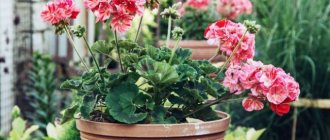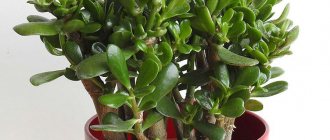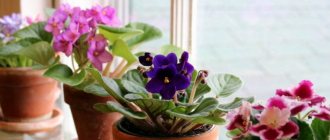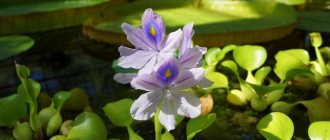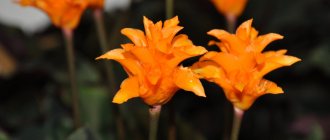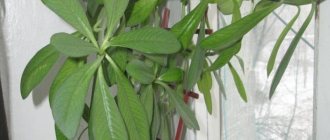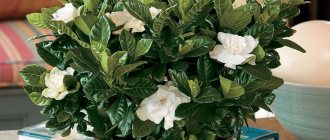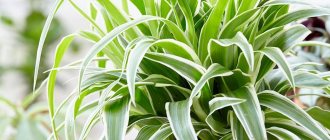If you are an avid gardener and pet owner at the same time, you should know that there are houseplants that are poisonous to dogs and cats. Oleanders, epipremnums, azaleas, crotons, caladiums, monsteras, dieffenbachias, poinsettias, philodendrons, many ficuses and lilies are toxic...
But what to do if you want beauty in your apartment, but you are under no circumstances ready to get rid of your four-legged family pet? Don't panic - there are many types of ornamental flowering and ornamental foliage plants that are safe for animals.
Today we have prepared for you a small selection of such flowers, which if you start them at home, you won’t have to worry about the health of dogs and cats at all, even if they try the plants or taste the water from the trays.
Pilea
Various ornamental pileas belong to the Nettle family. Unlike their wild relatives, indoor Pileas have a wide variety of sizes, textures, colors and shapes of leaves - sometimes it’s even hard to believe that they all belong to the same genus.
The leaves of different saws can be glossy or pubescent, flat or curved, tiny or large, smooth or with bubbly protrusions of various shapes, sharp-toothed or perfectly round, plain (green, brown, red-brown) or covered with contrasting spots and stripes... But they bloom these beauties are very inconspicuous and almost invisible.
Various types of pili may be sold under "folk" names such as "Chinese money tree", "mission plant", "aluminum plant", "Japanese dollar", "Creeping Charlie", etc.
An abundance of bright direct light is contraindicated for Pileas - they are adherents of partial shade and diffused lighting. It will tolerate short-term drought well, but ideally the plant likes frequent but light watering with mandatory drying of the surface layer of soil between procedures and summer spraying (excess moisture from the trays must be drained, especially in the cold season). She also doesn’t need heat, the optimal growing temperature is 15-18°C in winter and not higher than 20-25°C in summer. The plant needs year-round universal fertilizing - once a month in winter, 2 times a month the rest of the time.
The beneficial effect of pili on the composition of the air in the house is also known.
- Indoor flowers for your kitchen: 20 ideal options
Indoor flowers suitable for growing in the kitchen.
Homemade repellent
Citrus peels can be successfully replaced with essential oils. Just dilute a few drops in water and the cat repellent is ready. To enhance the effect, the mixture is sprayed in the air next to the plants, or you can sprinkle the soil in the pot. It is necessary to ensure that the liquid does not get on the plant itself.
IN THE PHOTO: A small container with a spray bottle is perfect for storing cat repellent.
To prepare a spray to save flora, you need to mix:
- 60 ml. water;
- 2 drops of lemon essential oil;
- 2 drops of wild orange essential oil;
- 2 drops of lavender essential oil.
Phalaenopsis
Phalaenopsis is perhaps the most common orchid in our apartments, a kind of “exotic for beginners.” And all because of her unpretentiousness.
This plant is epiphytic, it does not need soil, the orchid lives in a container with a special substrate based on the bark of coniferous trees. Direct sunlight can cause leaf burns, so place the phalaenopsis pot in an area with indirect light. Watering is required abundantly as the substrate dries. The optimal growing temperature is not lower than 22°C in summer and not lower than 18°C in winter.
Phalaenopsis has many decorative varieties and varieties, differing in the size of the plant, the number of peduncles, the size and color of flowers, the shape of buds, the duration of flowering, and so on.
- Mini, midi, standard and other varieties of phalaenopsis (+ the best varieties and hybrids)
Did you know that phalaenopsis plants can differ not only in the color of their buds?
Rue - cats don't like its smell
Common rue grows up to a meter in height and its flowers are small and yellow. The plant is not used to decorate houses, but it is used in herbal medicine. However, this is not the only function that a regular root can perform. Cats don't like its smell, so many people grow it in the garden to scare away unwanted guests.
Is your home visited by your neighbors' pets and are you concerned about the health of your cats? Then take care of your health and get ordinary rue, which will scare off uninvited guests with its aroma. Lavender will work in a similar way, but not all cats will bypass it.
- Common rue is a plant that decorates gardens and is used in herbal medicine. Cats don't like its smell, so you can sow it on your property to deter intruders.
Maranta
A beautiful arrowroot of American origin. Several species of this perennial herbaceous plant are popular in indoor floriculture. They differ mainly in the color of the wide, large leaves, which may have red or silver veins, as well as different-sized, multi-colored and variegated spots.
This plant is often called the “prayer flower” for its unusual ability to lift its foliage upward, for example, in the evening or under unfavorable growing conditions. It is also considered a flower that brings positive energy to the home.
Maranta is generally unpretentious. She prefers slightly acidic, fertile, well-drained soil, high air humidity, and bright but diffuse lighting. The optimal growing temperature is 21-27°C during the day and not lower than 15°C at night. Fertilizing (alternately organic and mineral) is carried out throughout the year at intervals of two weeks.
- Indoor plants that attract luck, money and bring happiness to the home
The magical properties of these plants can completely change your life! They are also suitable as a useful gift.
Poisonous plants for cats - what symptoms occur after ingestion?
Potted plants make a home feel cozier and the layout more interesting. However, visual considerations are not the most important thing, especially if you have a cat - it turns out that flowers can be very harmful to your pet. Do you think that your cat is not interested in plants, so they can be left out of the house? This is incorrect thinking because for some plant species, just trying a small amount once is enough to cause irreversible changes in the small organism.
Poisoning from toxic plants causes drooling, diarrhea, lethargy, abdominal pain, lack of appetite, seizures and even death. A bite from the plant may cause immediate symptoms or lead to poisoning only after some time. Dangerous plants cause the cat’s kidneys to work worse and worse, and the heart has an abnormal rhythm. Therefore, do not take risks and check all the plants that you have at home, and in this way you will protect your pet from poisoning.
Symptoms of toxic plant poisoning:
- salivation,
- diarrhea,
- abdominal pain
- lack of appetite
- convulsions,
- no desire to play
- kidney or liver weakness
- acceleration or deceleration of heart rate.
Some indoor and garden plants are very poisonous to cats.
Maidenhair
Small, fast-growing maidenhair ferns with creeping rhizomes and a “mane” of delicate feathery leaves can become a real decoration for your indoor flower garden.
Adinatums love humidity and warmth, but they cannot tolerate bright light - place them in partial shade. In addition to regular watering (preferably in a tray), they definitely require spraying (daily in the warm season). The growing temperature, even in winter and at night, should not fall below 15°C. Adianthuses are replanted once every two years, and in spring and autumn they are fed with complex fertilizer for ornamental foliage plants. In the spring, sanitary pruning of the plant is carried out to maintain its decorative appearance.
Many adianthuses do not tolerate air pollution very well, including cigarette smoke.
The easiest to grow are Ruddy's adiantum, "Venus hair", delicate and finely pubescent.
- Plants for the winter garden - which ones are right for you
Proven plants for the winter garden in the greenhouse, insulated veranda and indoors.
Deterrent fume
- Do not forget that felines have a poor sense of smell, so they cannot tolerate strong odors. You can use the sim. It is enough to take alcohol, a table bite, that is (i.e.) the zest of any citrus fruit. As an alternative, it is recommended to use black, pink, allspice and red pepper.
- You can use essences and citrus esters. Alcohol tinctures and fresh citrus peels are suitable. It’s also easy to make your own natural repeller for furry pests.
- It is enough to soak a cotton pad with a bite or alcohol. Keep in mind that such a palliative is only temporary. After the smell evaporates, the four-legged confidant can again take up old business. Therefore, every time you have to prepare a new trap.
Hibiscus
Beautifully flowering hibiscus can not only be a magnificent garden decoration, but also a compact indoor plant - most often in indoor floriculture, the species called the “Chinese rose” is used. Over the past few decades, many colorful varieties have been developed. Scarlet, white, pink, yellow, orange, as well as two-color huge hibiscus flowers with delicate thin petals will not leave any gardener indifferent.
This plant is fast growing, loves a lot of diffused light, frequent spraying (water should not get on the flowers!) and abundant watering. The optimal growing temperature is 20-23°C in summer and 14-17°C in winter. Hibiscus easily forgives small errors in care for beginning flower growers.
In the East, this plant is considered a guardian of the home, and hibiscus flowers can also be eaten - they can be fried in batter with cheese and breadcrumbs, added fresh to salads, or decorated with desserts and drinks.
- Flowers you can eat
9 plants from the flowerbed that can be added to a salad, pickled, stewed or placed on a cake as a decoration.
Why do cats dig up and eat flowers?
You won't solve the problem if your pet's behavior is related to physiological needs. For normal digestion, cats need coarse fiber; if there is not enough of it, the cat will “hysterically” eat plants and even toilet paper.
Cats can dig up and eat seedlings, suffering from vitamin deficiency. The second reason for digging flower beds is to find a cozy place to plant them. In this case, the cat will target flowers and seedlings, since the ground under them is loose.
Alternative methods of protecting plants from cats
An alternative method of dealing with the problem is adjusting the cat's behavior. Your pet should be encouraged in every possible way for correct behavior. If a cat, who often spoiled a flower, passed by the pot indifferently, you should immediately praise him in a gentle voice and give him something tasty.
If the owner sees that the cat is approaching the flowers, he should switch his attention to another object. It is important to diversify your pets' leisure time. There are quite a few events in their lives. You should pay attention to playing with the animal, purchase interesting toys with which the cat can entertain itself.
You also need to give the animals the opportunity to sit on the windowsill and watch what is happening on the street.
First aid
If any symptoms of illness appear in your pet, it must be immediately shown to a doctor. Only a veterinarian can make an accurate diagnosis and take all necessary measures.
If the animal exhibits all the symptoms of poisoning, first aid should be provided at home:
- It is necessary to give the cat a sorbent that will reduce the impact of toxins on the body (activated carbon, polysorb, adsorbent).
- You need to assemble a carrier. A diaper should be placed at the bottom in case the animal vomits or has diarrhea. You should take a towel and blanket with you in case your cat gets chills.
- If the animal does not have the strength to move and the vomiting does not stop, the cat should be placed on its side so that it does not suffocate from the vomit.
- You need to immediately see which plant caused the poisoning. This information will be useful to your veterinarian.
- It may be necessary to perform a gastric lavage with saline solution. But this option should only be used if it is not possible to urgently take the animal to a doctor. It is better if the veterinarian monitors the procedure at least by telephone.
Flower poison in the cat's body
Toxins tend to accumulate in the body and, when reaching a critical amount, cause damage. It often happens that a cat regularly chews several leaves while the owner is busy with important matters. And the pet’s behavior does not reveal its pranks for a long time. The cat is healthy and cheerful, but for the time being. Every leaf can be the last.
Flower poison destroys the animal’s body, leading to such terrible conditions as laryngeal edema, gastrointestinal upset, and heart rhythm disturbances. If the body is weak, or too much flower is eaten, the pet may stop breathing.
